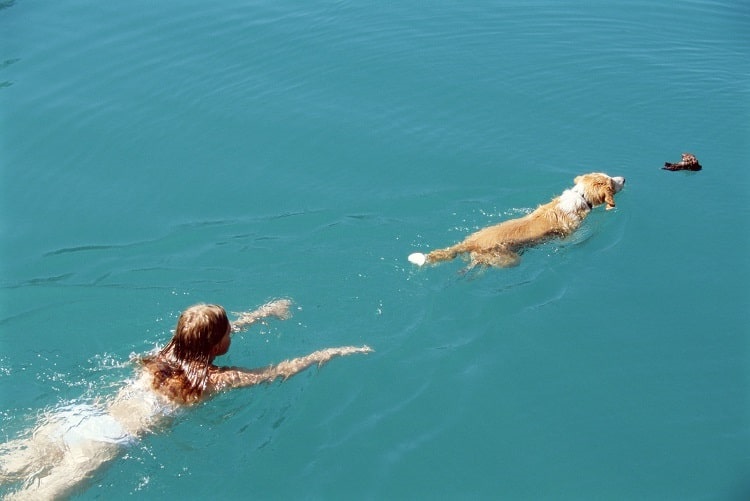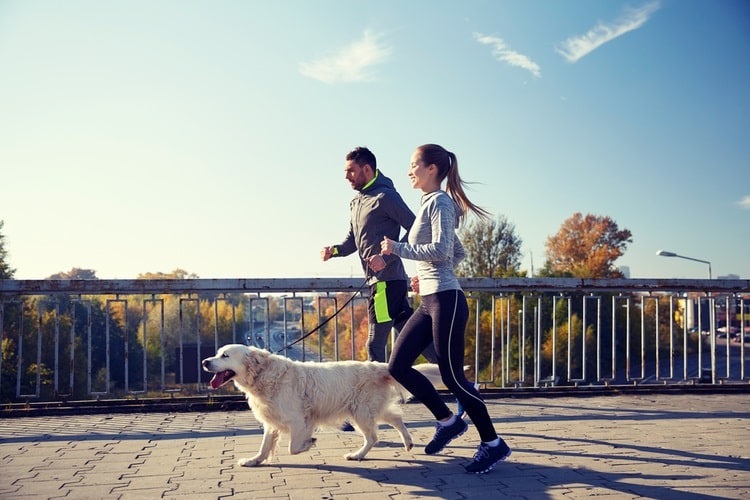Dog owners often want to know how much exercise a dog needs daily to ensure that they’re providing enough activities to help their furry friends get adequate exercise. In this post, I’ll discuss how much exercise a dog needs daily and tips for helping your dog get enough daily activity.
We all want to take the very best care of our best friends. That means feeding them high-quality food, spending time with them, and getting them plenty of exercise. While you can measure the quality and amount of food you give and increase the amount and quality of time you spend with them (and even answer questions like “how much will my puppy weigh?” and “what’s the ideal weight for a dog?”), it can sometimes be hard to know if they’re getting enough exercise. We’re here to help! Read on to find out how much exercise your pup needs daily and ways that they can get it.
How Much Exercise Does a Dog Need Per Day?
As with people, there is no one-size-fits-all answer to how much exercise a dog needs daily. There are many factors that impact the ideal amount of daily exercise for a dog, such as their age, breed, and health status. If you’re looking for some basic guidance on how much exercise a dogs need, most dogs need between 30 minutes and two hours of exercise per day.1
Small breeds that prefer your lap over a walk will typically need an amount of exercise on the lower end of that range, with 20-30 minutes per day being sufficient for most. More active small breeds may prefer to exercise for closer to an hour.
Large or giant breed dogs typically need moderate amounts of exercise since it takes a lot of energy to move their big frames around. Look to give them 30-60 minutes of exercise per day.
Working, hunting, and herding breeds will typically need about two hours of exercise per day. This group includes terriers and hounds.
Of course, there will be some variation from these guidelines among individual dogs. Some dogs buck the tradition and are more or less active than their counterparts. You’ll have to adjust exercise regimes to fit your dog’s individual needs. Also, senior pups or those with health issues like arthritis, heart conditions, brachycephalic syndrome, or injuries often require less exercise per day.234 Speak with your veterinarian about the recommended exercise requirements for your specific pooch.
What Happens If My Dog Doesn’t Get Enough Exercise?
Shorting your dog on exercise one or two days a week usually isn’t a big deal for most dogs. However, repeatedly missing exercise sessions can be detrimental, even for less active dogs. Exercise is so important for both physical and mental health. In fact, insufficient exercise for pups can result in the following:
- Obesity: The less exercise a dog gets, the more chance they have of gaining weight. Exercise is important for burning calories that can build up as fat in the body if they’re not used. An obese dog is at risk for many health issues including diabetes, heart disease, and arthritis.
- Injuries: Besides burning calories, exercise also helps to strengthen muscles, bones, and joints. It can improve flexibility to help prevent everyday injuries like sprains and strains, and even more serious injuries like fractures and torn ligaments.
- Destructive behavior: A dog’s energy has to go somewhere. If it isn’t burned through exercise, it may be used up by destroying your couch and rugs. Dogs that don’t get enough mental and physical stimulation can often resort to neurotic or anxious behaviors that can be detrimental.5 Under-exercised dogs may also bark or whine more and be clingier. They may also be hyperactive when you do get them out and drive you crazy with their leash pulling and short attention span.
- Depression: Most dogs are very social critters. They like the company of people and other animals. Exercise is a way of getting them out and about to enjoy the world around them (and that time with you). Without regular exercise, even low-energy pups can become withdrawn and disinterested in their everyday life.
How to Exercise Your Dog

It may go without saying that it’s not always easy to devote a half-hour or more a day to walk with your pup, especially if your dog is on the high-energy end of the spectrum. It’s time to look at exercising your dog differently and get creative!
Break It Up
You don’t have to have set aside a two-hour block to get your pup the workout they need. Rather, breaking that time into smaller chunks may be easier for both you and your dog to handle. Take a quick walk before work, play fetch when you get home, and take another walk before bed. Bonus points if you can squeeze in a walk or game during your lunch break.
Play
Exercise doesn’t have to be limited to just walking through your neighborhood but can also include swimming, hiking, biking, and play. Most dogs love to play, and a game of fetch or tug-of-war provides plenty of physical benefits. Obedience classes and dog parks are another great way to get your dog moving and socializing at the same time.
You may choose to incorporate interactive toys into your dog’s routine. These toys are a great tool for giving your dog’s mind and body a workout, all without you being there.
Treadmills
If you’re extremely pressed for time, the weather isn’t cooperating, or you don’t have easily accessible outdoor space, look into treadmills for dogs. There are many options to choose from to accommodate what your dog needs as well as your available space and budget.
Final Thoughts
Exercise is an important component of your dog’s daily needs. It plays a big role in the overall health and happiness of our best friends. If you’re ever in question of your dog’s exercise needs, be sure to visit with your veterinarian.
If part of your concern about exercise is the size of your specific breed, you can learn more with our growth charts about the average weight for a goldendoodle, the average weight for a great dane, the average weight for a chihuaha, the average weight for a golden retriever, or the average weight for a labrador.
And of course don’t forget that the proper amount of exercise can help your dog or puppy sleep through the night – if that’s an issue and part of your interest in exercise, you may also find our series of guides on purchasing the right dog bed useful. We have buying guides for the best waterproof dog bed, the best outdoor dog bed, the best elevated dog bed, and the best sofa dog bed.
Article Sources
Pet News Daily uses only high-quality sources, including peer-reviewed studies, to support the facts within our articles. Read our editorial process to learn more about how we fact-check and keep our content accurate, reliable, and trustworthy.
- Academy Animal Hospital. Does My Dog Need Longer Walks? Academyanimal.com. Published March 1, 2020. Accessed February 28, 2021.
- American Kennel Club Canine Health Foundation. Managing Canine Arthritis. Akcchf.org. Published September 19, 2011. Accessed February 28, 2021.
- CVCA. Heart Disease in Dogs. Cvcavets.com. Accessed February 28, 2021.
- American College of Veterinary Surgeons. Brachycephalic Syndrome. Acvs.org. Accessed February 28, 2021.
- Tiira K, Lohi H. Early Life Experiences and Exercise Associate with Canine Anxieties. PLoS One. 2015;10(11):e0141907. Published 2015 Nov 3. doi:10.1371/journal.pone.0141907

